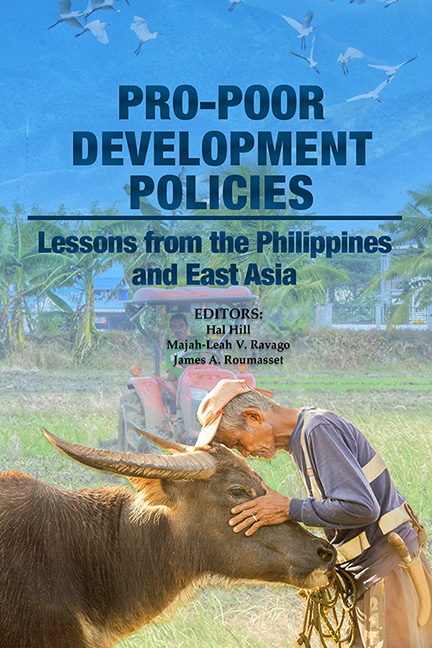Book contents
- Frontmatter
- Dedication
- Contents
- Figures, Tables and Boxes
- Foreword
- Foreword
- Message
- Preface and Acknowledgements
- About the Editors
- About the Contributors
- Acronyms
- Part 1 Introduction and Synthesis
- Part 2 Agricultural and Economic Development
- Part 3 Economic Policies for Achieving Targeted Levels of Living in the Philippines
- Part 4 Inequality and Economic Development
- Part 5 Competition Law and Policy
- Part 6 International Dimensions
- Index
10 - The Philippines in Global Manufacturing Value Chains: A Tale of Arrested Growth
Published online by Cambridge University Press: 09 January 2024
- Frontmatter
- Dedication
- Contents
- Figures, Tables and Boxes
- Foreword
- Foreword
- Message
- Preface and Acknowledgements
- About the Editors
- About the Contributors
- Acronyms
- Part 1 Introduction and Synthesis
- Part 2 Agricultural and Economic Development
- Part 3 Economic Policies for Achieving Targeted Levels of Living in the Philippines
- Part 4 Inequality and Economic Development
- Part 5 Competition Law and Policy
- Part 6 International Dimensions
- Index
Summary
INTRODUCTION
Cross-border dispersion of the different stages/slices of production processes within vertically integrated global industries has been a key structural feature of economic globalization in recent decades. This international division of labour, which we label “global production sharing” in this chapter, opens opportunities for countries to specialize in different slices (tasks) of a production process within a global manufacturing value chain (GMVC). Trade based on global production sharing—that is, trade of parts and components and final assembly within GMVC—has primarily driven the dramatic shift in the geographical profile of world manufacturing exports from developed to developing countries. High-performing developing countries in East and Southeast Asia have been the main beneficiaries of this structural shift in world trade. In the early 1970s, the Philippines had a promising start in export‑oriented industrialization by engaging in GMVCs. But subsequently, its growth trajectory has not lived up to the initial expectations.
This chapter aims to document and analyse the Philippines’ engagement in GMVCs from a comparative Southeast Asian perspective. This has been motivated by two related objectives: (a) to inform the policy debate in the Philippines on the feasibility and desirability of export‑oriented industrialization by joining GMVCs and (b) to contribute to the wider literature on GMVC participation as a vehicle for global economic integration of developing countries and the related policy issues. The importance of this phenomenon in designing national industrialization strategies is now widely acknowledged in both academic and policy circles. However, there is a dearth of time-profile studies of individual countries, which are needed to broaden our understanding of how government policies and the overall investment climate condition a country’s potential for export-oriented industrialization by joining GMVCs. The Philippines provides a valuable laboratory for a case study of this subject, given the country’s engagement in global production sharing since the early years of the GMVCs’ arrival in the region and its mixed achievements in the ensuing years compared with other Asian countries.
The next section presents a brief typology of GMVCs to provide the analytical context for the ensuing analytical narrative.
- Type
- Chapter
- Information
- Pro-poor Development PoliciesLessons from the Philippines and East Asia, pp. 246 - 279Publisher: ISEAS–Yusof Ishak InstitutePrint publication year: 2022

